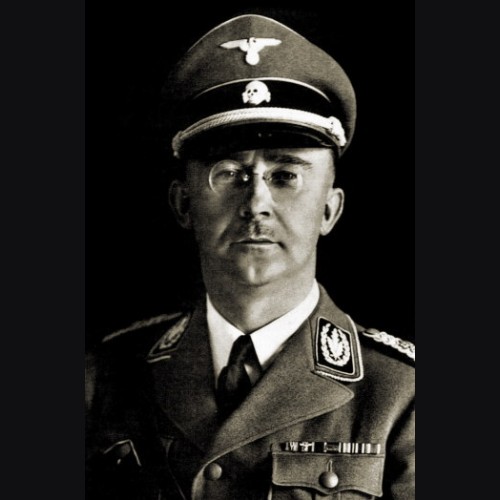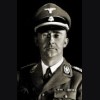A1. Heinrich Himmler # 493
Heinrich Himmler joined the SS in 1925 and in 1927 became deputy–Reichsführer-SS. Himmler was appointed Reichsfuhrer in January 1929. The SS then had several hundred members and was secondary to the SA.
By 1933, the SS numbered 52,000 members. The organization enforced strict membership requirements ensuring that all members were of Aryan descent. Himmler and his deputy Reinhard Heydrich, began an effort to separate the SS from SA control. Black uniforms replaced the SA brown shirts in the autumn of 1933. Shortly thereafter, Himmler was promoted to Reichsführer-SS and became an equal of the senior SA commanders, who by this time loathed the SS and its power.
Leader of the SA, Ernst Rohm was becoming a threat to the German army and the Nazi leadership with his socialist views, Rohm felt that his SA should be the sole armed guard of the state. A fear of a coup by Himmler and Goring who had Hitler's ear, were able to put an end to any threat from the SA.
The murder of Ernst Rohm. would come to be known as the "Night of Long Knives" And was carried out by Theodore Eicke and other high ranking SA officials. Upwards to 90 political enemies of the state and Hitler were executed. The SA street thugs and Rohm's supposed threat to the state was no longer. Heinrich Himmler was free to establish his own state within a state. This would become the most feared group within the Reich. The SS.
The porcelain factory Allach was established as a private concern in 1935 in the small town of Allach, near Munich. In 1936 the factory was acquired by the SS. Heinrich Himmler saw the acquisition of a fine porcelain factory as a way to establish an industrial base for the production of works of art that would be representative, of truly Germanic culture. Allach was one of His favorite projects and produced a multitude of pieces to compete in the small but profitable German porcelain market.
High-ranking artists were locked into contract. The program of the factory included over 240 porcelain and ceramic models. As output at the Allach factory increased, the Nazis moved production to a new facility near the Dachau concentration camp. The fact that the factory might have been taking advantage of a pool of slave labor provided by the Dachau camp was strongly denied by the factory managers at Nuremburg. Initially intended as a temporary facility, Dachau remained the main location for fine porcelain manufacture even after the original factory in Allach was modernized and reopened in 1940. The factory in Allach was instead retrofitted for the production of ceramic products such as household pottery.
Allach was a sub-camp of the Dachau concentration camp near the main camp at Dachau. The liberation of Europe and the fall of the Third Reich brought an end to the Allach concern. The Allach factories were shut down in 1945 and never reopened.
Hunted by the Allies, Himmler wandered for several days near the Danish border. Attempting to avoid arrest, he disguised himself as a sergeant-major of the Secret Military Police, using the name Heinrich Hitzinger, shaving his moustache and donning an eye patch over his left eye. He had equipped himself with a set of false documents, but someone whose papers were wholly in order was so unusual that it aroused the suspicions of a British unit in Bremen. Himmler was arrested in May, and in captivity, was soon recognized. Himmler was scheduled to stand trial with other German leaders as a war criminal at Nuremburg, but committed suicide by swallowing a cyanide capsule before interrogation could begin. The circumstances of his death are still open to controversy today.
Heinrich Himmler
Heinrich Himmler joined the SS in 1925 and in 1927 became deputy–Reichsführer-SS. Himmler was appointed Reichsfuhrer in January 1929. The SS then had several hundred members and was secondary to the SA.
By 1933, the SS numbered 52,000 members. The organization enforced strict membership requirements ensuring that all members were of Aryan descent. Himmler and his deputy Reinhard Heydrich, began an effort to separate the SS from SA control. Black uniforms replaced the SA brown shirts in the autumn of 1933. Shortly thereafter, Himmler was promoted to Reichsführer-SS and became an equal of the senior SA commanders, who by this time loathed the SS and its power.
Leader of the SA, Ernst Rohm was becoming a threat to the German army and the Nazi leadership with his socialist views, Rohm felt that his SA should be the sole armed guard of the state. A fear of a coup by Himmler and Goring who had Hitler's ear, were able to put an end to any threat from the SA.
The murder of Ernst Rohm. would come to be known as the "Night of Long Knives" And was carried out by Theodore Eicke and other high ranking SA officials. Upwards to 90 political enemies of the state and Hitler were executed. The SA street thugs and Rohm's supposed threat to the state was no longer. Heinrich Himmler was free to establish his own state within a state. This would become the most feared group within the Reich. The SS.
The porcelain factory Allach was established as a private concern in 1935 in the small town of Allach, near Munich. In 1936 the factory was acquired by the SS. Heinrich Himmler saw the acquisition of a fine porcelain factory as a way to establish an industrial base for the production of works of art that would be representative, of truly Germanic culture. Allach was one of His favorite projects and produced a multitude of pieces to compete in the small but profitable German porcelain market.
High-ranking artists were locked into contract. The program of the factory included over 240 porcelain and ceramic models. As output at the Allach factory increased, the Nazis moved production to a new facility near the Dachau concentration camp. The fact that the factory might have been taking advantage of a pool of slave labor provided by the Dachau camp was strongly denied by the factory managers at Nuremburg. Initially intended as a temporary facility, Dachau remained the main location for fine porcelain manufacture even after the original factory in Allach was modernized and reopened in 1940. The factory in Allach was instead retrofitted for the production of ceramic products such as household pottery.
Allach was a sub-camp of the Dachau concentration camp near the main camp at Dachau. The liberation of Europe and the fall of the Third Reich brought an end to the Allach concern. The Allach factories were shut down in 1945 and never reopened.
Hunted by the Allies, Himmler wandered for several days near the Danish border. Attempting to avoid arrest, he disguised himself as a sergeant-major of the Secret Military Police, using the name Heinrich Hitzinger, shaving his moustache and donning an eye patch over his left eye. He had equipped himself with a set of false documents, but someone whose papers were wholly in order was so unusual that it aroused the suspicions of a British unit in Bremen. Himmler was arrested in May, and in captivity, was soon recognized. Himmler was scheduled to stand trial with other German leaders as a war criminal at Nuremburg, but committed suicide by swallowing a cyanide capsule before interrogation could begin. The circumstances of his death are still open to controversy today.
Heinrich Himmler



